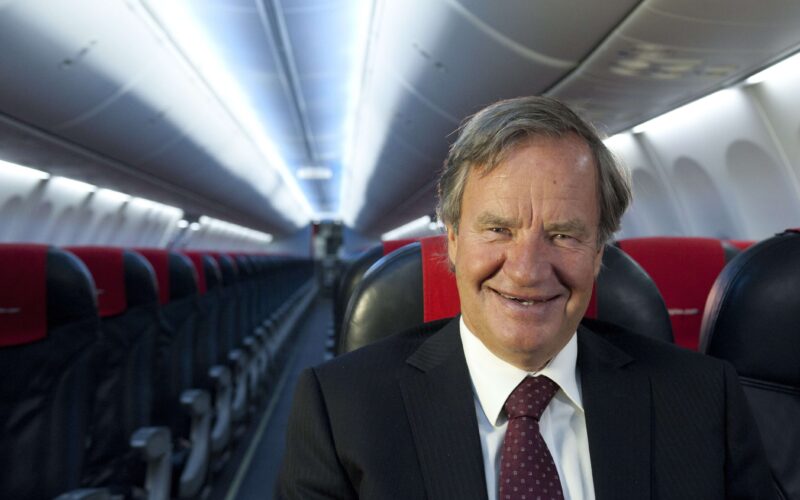Despite Norwegian Air’s withdrawal from flying long-haul going forward amidst its restructuring process, the former chief executive of the airline is still a firm believer in the model. So much so, that he, with several other high-level aviation executives, has established Norse Atlantic Airways – a new low-cost long-haul airline, based on the same model that Norwegian Air had operated.
The new airline, Norse Atlantic Airways (NAA), will be led by Bjørn Tore Larsen, who is the founder and the general manager of NAA. Larsen will be joined by Bjørn Kjos, a former Chief Executive Officer (CEO) of Norwegian Air Shuttle. Kjos departed from the company in 2019, as the low-cost carrier struggled to keep its debts in check and the airline was forced to reorganize its business model. Another former Norwegian executive, Bjørn Kise, was also presented as one of the early investors.
In total, Larsen, Kjos and Kise will hold 63%, 15% and 12% of NAA’s total shares. However, the company will also look to raise as much as $24 million on the Oslo Stock Exchange in April 2021. The “investor community has already expressed great interest in the new airline,” read the press releae by NAA.
Larsen and Kjos will also be joined by Espen Høiby, who will hold the role of Chief Operating Officer (COO) and James Lightbourn, an experienced executive within the shipping industry, who will be the Chief Financial Officer (CFO).
NAA looks to start selling tickets starting in mid-Q3 2021. The first flight scheduled to take-off in December 2021.
The airline will look to obtain 12 of Norwegian Air’s former Boeing 787 Dreamliners, all 37 of which were returned to their lessors. While some aircraft have found new homes with airlines, like the Italian Neos, many are currently stored as the downturn in international travel demand as a result of the pandemic has crippled the demand for wide-body aircraft.
Right time to establish airline
“It is a very right time to start long-haul now,” Kjos was quoted as saying by the Norwegian business journal Dagens Næringsliv (DN). According to NAA’s press release, which announced the launch of the airline on March 15, 2021, the 787s are “leased at favorable rates and have a high cabin utilization,” which will help to keep costs down and “ensure its customers attractive offerings at low fares.”
“We have industry knowledge and have secured modern Dreamliners at very good terms,” reiterated Larsen. The new chief executive told DN that the airline obtained the 787s at “around half price.”
Initially, Norse Atlantic Airways will operate 12 Boeing 787 aircraft, flying between Europe and North America. Amongst their potential destinations, the new long-haul low-cost carrier highlighted London, Oslo and Paris on one side of the Atlantic, and New York, Miami and Los Angeles on the other.
“The airline will offer routes that have already proved to be popular for leisure and business travelers alike, including destinations such as New York, Los Angeles, Miami, London, Paris, and Oslo,” read a statement by the airline.
The push to establish NAA came from Norwegian Air, which announced in January 2021 that going forward, it would no longer operate long-haul flights going forward. The low-cost carrier, which has been operating under bankruptcy protection in Ireland and Norway, has been crippled with massive debts stemming from its expansion into the long-haul market, which started in 2013.
Blank sheet
While the move helped Norwegian to obtain an assurance from the local government that it would support it with a hybrid loan, the decision to ax flights over the Atlantic left a gaping hole in the market that NAA looks to fill. Starting with a “blank sheet” with no debt could undoubtedly help the new airline weather any downturns in demand and pressure from its competitors. After all, Norwegian did highlight that it still had hope in the low-cost long-haul model as recently as August 2020, as the current CEO of Norwegian Jacob Schram stated that the airline still had a portfolio of profitable routes in its long-haul network.
Perhaps another argument in favor of NAA will be the fact that Rolls-Royce has moved forward to fix the issues with the Trent 1000 engine, which powered Norwegian’s 787s. The low-cost carrier was plagued with issues regarding the aircraft and its power plant – so much so, that in 2013, the airline’s spokesperson slammed the 787 for “simply not acceptable” reliability.
Three separate issues have plagued the Trent 1000 over the course of the past several years, resulting in as many as 42 Boeing 787 aircraft being grounded at the peak of the issues in H1 2019. The current crisis in the industry has provided a helping hand for Rolls-Royce, as the reduced utilization of wide-body aircraft allowed the manufacturer to not only have no Aircraft on Ground (AoG), but to also build up the availability of spare engines to reduce the disruptions of operations possibility for airlines.

